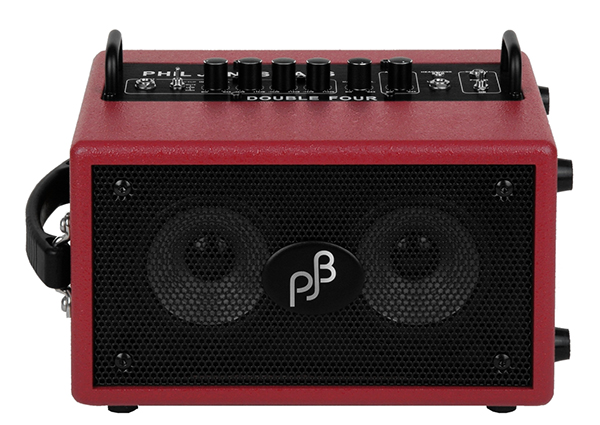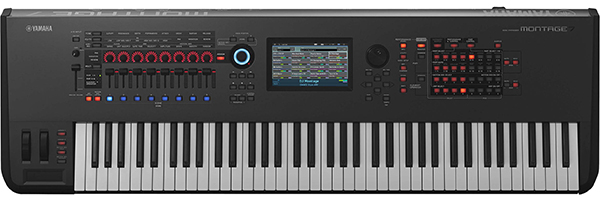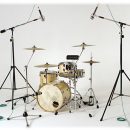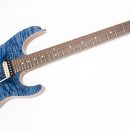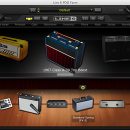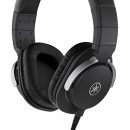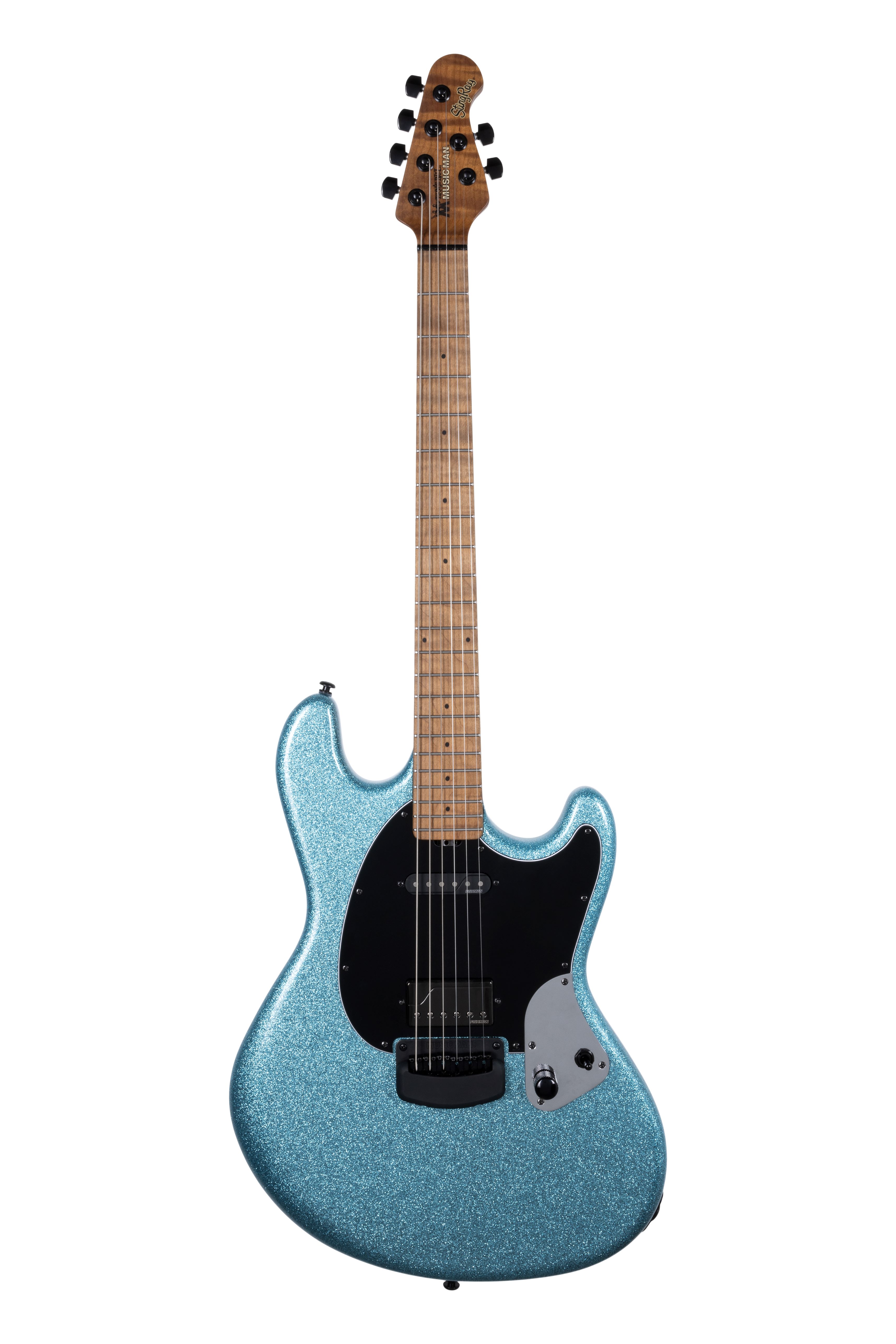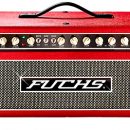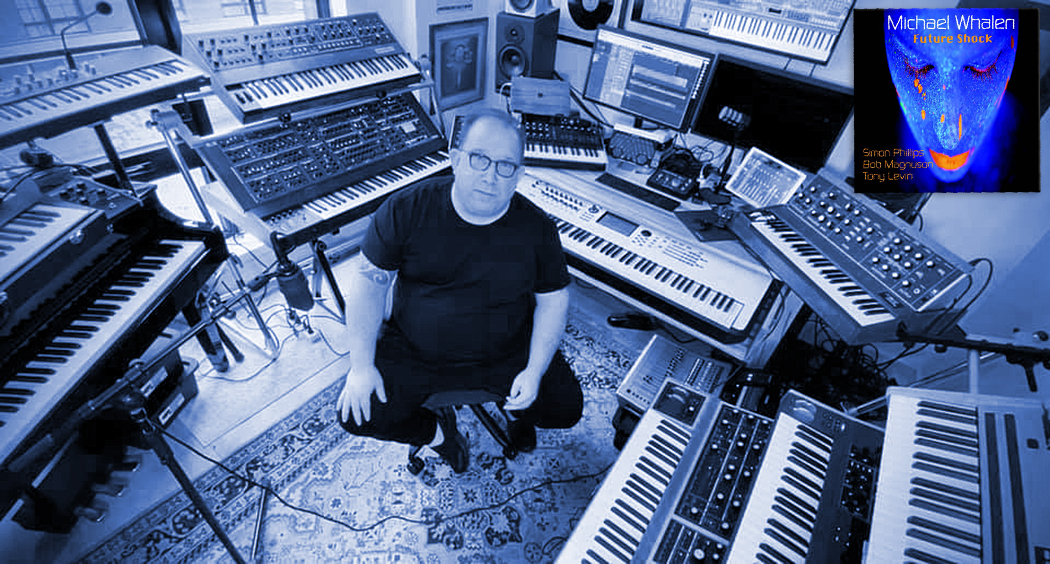From the analog Junos and Jupiters to the digital D-50s, XP and XV series synths, Roland has long been an integral part of pro studios and stage rigs. Roland synths have been heard on countless hit songs, and our MusicPlayers.com keyboard team have owned (and still own) a wide range of these beloved sound machines.
Having said that, over the last few years, you could arguably say that Roland hadn’t created a synth that made professional keyboard players say “I have to have it… now!” As much as we love Roland gear, most of the recent products have been more evolutionary than revolutionary. The Boutique keyboards were fun, and the JD-Xi was pretty cool for synth with mini keys, but still… we needed something with the pro-level appeal of the Jupiter-80 but a bit more focused on synth sounds. And then came along the Roland JD-Xa, giving us something that is one of the most innovative synths Roland has built in quite some time.
Combining a four-voice analog synth engine with a sixty-four-voice digital sound engine derived from Roland’s Supernatural sound libraries, a mic-in jack for vocoding, multi-effects, a sequencer, an arpeggiator, lots of real-time controls, and USB, MIDI, and CV connectivity, the JD-Xa is a very interesting piece of gear indeed. And while at first glance the keyboard may look like certain American synths, the sound it produces is most definitively Roland.
Features
Clearly taking a style cue from DSI instruments, the JD-Xa features red backlighting all over the place, which against the polished black panel gives it a very futuristic look. The JD-Xa’s keyboard has forty-nine keys (four octaves) and features velocity and channel aftertouch. While the action is good—fast as you would expect on a synth—we admit we are getting a little tired of the “fewer keys is better” attitudes most synth companies have these days (especially considering Roland had the good sense to give the Jupiter 80 a 76-key keyboard). Given you can have zones for up to eight individual parts—four analog and four digital—it’s unfortunate that we don’t have at least sixty-one keys to play with. The keys themselves also seem a little bit shorter than typical synth keys, though certainly not mini keys by any stretch.
Once you get past the 49/61-key debate, you can turn your attention to the front panel. This is definitely one of the JD-Xa’s strengths. Every knob, slider, and button is either backlit or contains an LED, so just about everything lights up. There are also two, three-character LED lights and an additional, two-line LCD screen to show values, patch names, and more. Importantly, all of these controls provide immediate gratification without menu diving. A nice touch is that any time a button/slider/knob is moved, the LCD screen immediately shows that control’s value (and the parameter name too). Unfortunately, since it still is a small screen, if you were, for example, to turn two knobs at the same time, the screen only shows values for one of the controls.
The JD-Xa sports the Roland-ubiquitous horizontal joystick control for modulation/pitch bend, but also adds two modulation wheels above it. This is a nice addition that is atypical for Roland, as many of their synths only have the single joystick control. Similar to our classic Juno 106, the JD-Xa has 18 sliders, which we love. Knobs are perfectly fine, and they adorn other manufacturers keyboards sometimes exclusively, but we love how the JD-Xa mixes the controls up with knobs and sliders where appropriate.
The JD-Xa sports two different sound engines, and might be best thought of as two synths that can be layered or split, together in one box. The analog engine has four parts, with two oscillators per voice, and each part can run as an independent two-oscillator monosynth. However, you can also engage Polystack (a dedicated button on the upper left), which takes any one of the two-oscillator analog monosynth parts and turns it into a four-note polyphonic analog synth. When running in monosynth mode, you can stack all eight analog oscillators together across the four analog parts, with two distinct waveforms and filter/envelope settings on each of the parts.
You can also set up separate two-oscillator sounds on each part within Polystack mode, and then choose which part is the main focus for your “polystacked” sound using the four independent On buttons (the focused part turns the LED button yellow), which is a way for you to have four separate poly sounds ready to go within a single Program. It is a little confusing until you are accustomed to it, and to denote which of the four parts you are editing, the LED light on the part button turns blue. These buttons are all on the upper left of the control panel, under the printed “Analog Part” heading.
The onboard waveforms include saw, square, pulse/PWM, triangle, and sine. These are selected by a larger rotary knob, which certainly works, but those printed waveforms are really small to see! To be clear, an analog voice consists of two oscillators, a choice of filters, a pair of LFOs, an LFO dedicated to the mod wheel, plus envelopes for the filter, amplifier and pitch. These choices are essentially what all the controls across the panel are about. We won’t go through every single knob one by one, but we thought the panel was laid out well, although understanding the way to use analog parts initially took some getting used to.
Let’s explore the JD-XA’s two LFOs per analog part, named LFO1 and LFO2. A dedicated button determines which LFO you’re currently editing. Six waveforms are available per LFO: sine, triangle, downward sawtooth, square, sample-and-hold, and random. A dedicated Rate knob adjusts the speed, which can also be tempo-synced. Four sliders below the LFO knob allow adjustment of several parameters. Fade Time adjusts how soon the LFO reaches its maximum amplitude, allowing modulation from the LFO to fade in over time. Dedicated Pitch Depth, Filter Depth, and Amp Depth sliders are also present to adjust their respective parameters.
The nomenclature Roland uses for the two digitally-controlled analog oscillators are called A-OSC1 and A-OSC2. The two oscillators can be set independently via their own dedicated rotary switch to one of five waveforms; sawtooth, fixed square, square with pulse width modulation, triangle, and sine. You can’t assign more than one kind of waveform per oscillator. Each oscillator also has dedicated knobs for coarse and fine-tuning.
Both oscillators have dedicated pulse width modulation (PWM) sliders, one for the depth of the modulation and one for the actual width. Each oscillator can be modulated be either LFO.
A-OSC1 also has a Cross Mod knob. This controls the amount of audio-rate modulation into the frequency of A-OSC1 from one of two sources: A-OSC2 or an auxiliary source which you select by the dedicated Mod Source button. The sources include a separate noise generator oscillator (white or pink), one of the synth’s Digital Parts, or the mic input. This is pretty cool as this means you can modulate the analog waveform with a digital waveform or even incoming audio.
Ring modulation is also available, with either A-OSC2 or the Aux as the source. There’s also Hard Sync, which forces both oscillators always to begin their waveform cycles at the same time.
In the right-of-center panel is the mixer section. It contains dedicated knobs for the level of both oscillators and the aforementioned Aux source/noise generator level knob and source selection switch.
Next to the mixer section on the right is the filter section. The first, smaller knob controls a separate high-pass filter. A Drive knob adds some distortion by driving the input harder. A larger knob allows you to select from five different filter types (and bypass as well): LPF1, a 24dB-per-octave filter based on Roland’s classic designs; LPF2, Roland’s interpretation of the Moog-style ladder filter; then LP3, HPF, and BPF, which are all part of a multimode 12dB-per-octave setup.
The Cutoff knob interestingly has a red cap, assumingly to catch your attention. Resonance, Key Follow, and Envelope Depth knobs round out the top part of the filter section. Below them is a dedicated envelope generator with four sliders for each stage (our beloved ADSR sliders). Next to this is the amp section with its own set of ADSR sliders.
If you made it through all that… congrats! The digital engine is a bit more straightforward, though you have even more choices in the filter selection.
The digital section buttons are just below the analog section, and the four parts are selected in a similar manner as evidenced by another two rows of four buttons.
One of the differences in working with the digital oscillators is that only the controls for A-OSC1 are active (the LEDs for A-OSC2 go dark). There are three partials for that oscillator and each partial can contain one of 448 waveforms, including variations on all the basic waveforms available to the analog oscillators, as well as a variety of sampled content. Each partial can be edited separately or together, and there are similar selection buttons for them.
Another difference is that you have 64-voice polyphony. While we wish this was 128, 64 voices should be plenty to get by most situations (although six or eight analog voices would have been even more useful). Each digital part can be monophonic or polyphonic independently of the other parts, so this does provide for some interesting possibilities.
The digital engine itself is derived from Roland’s Integra-7 sound module and interestingly, is compatible with Supernatural Synth Tone Libraries on Roland’s Axial website. The digital filter sections have been expanded to fourteen types, and each of the four digital parts can have its own virtual analog waveform including saw, square, triangle, sine, and supersaw.
Roland recently released a librarian software application for the JD-Xa, which not only allows for easy organization of your patches, but also converts Integra-7 patches for use on the JD-Xa. Pretty cool! Also, you can also directly download collections of sounds from Axial’s website into the librarian, to then be saved into the JD-Xa itself. We noticed there was a Jupiter 8/Juno 60 collection, which is beyond the scope of this article but does reinforce that we wish there were more analog voices available!
The effects section on the JD-Xa is quite nice, and we were pleased to see dedicated controls for them (on the far right of the panel). Dedicated knobs for commonly used effects such as reverb and delay are always welcome! Two global, selectable effects slots augment the dedicated reverb and delay, called TFX1 and TFX2 (with the “T” standing for Total). There are twenty-nine different effects to choose from including loopers, bitcrushers, wahs, tape echo, modulation (chorus, phaser, flanger), panning, distortion, EQ, and a cool vinyl record simulation. TFX1 and TFX2 each have two dedicated knobs for choosing the effect and adjusting a single parameter, such as chorus depth or delay time.
But wait—there are more effects available! Besides the “total effects” (TFX), each of the four Analog and four Digital Parts has its own MFX (multi-effects) slot, with sixty-seven different effects available. These include reverbs and delays, rotary sims, electric piano amp simulators, filters, lo-fi, and twenty-two combination effects chains. These can be turned off or on per Part via a button.
Some of what we have already described is similar to the diminutive JD-Xi (though this is a significantly more advanced synthesizer). While the JD-XA does not ship with a microphone for the vocoder like its baby brother, it does feature an XLR microphone input (with phantom power), enabled in a menu. Happily, here the vocoder does not disable the analog section (it does on the JD-Xi). The modulation destinations include filter cutoff and resonance, amp, pitch, and several parameters for the LFOs.
The sequencer is in the bottom right-hand corner, and is a 16–track, pattern sequencer capable of driving each of the eight internal parts, plus eight external parts. The sequencer can memorize a unique tempo (and even tempo changes) for all 256 programs. Tracks can be up to four bars long, and your patterns are assumed to be in regular 4|4. Recording is either real–time or note–at–once, step input and includes scale options, in which 32nd notes can be selected, thus imitating eight bars at half tempo.
The arpeggiator has a dedicated button, though you do have a few menu steps to navigate to get to the pattern selection.
Rounding out the back, there is a headphone jack, L/R main output jacks, an analog dry out, a click output (like on our Roland XP-80!), Mic jack (input for vocoder), CV/Gate mini jacks, three footpedal jacks, MIDI In/Out, two USB jacks (one for computer connection, one for memory stick), and DC input jack. Remarkably, the JD-Xa weighs under 15 pounds.

Usability
Upon first glance, the JD-Xa may seem a little bit confusing, but after learning the architecture of the dual sound engines on the JD-Xa, we found it pretty easy to navigate around.
The JDXa stores 256 internal programs stored in banks A–P, (sixteen presets per “letter” bank) and with an additional USB flash drive, it can hold a further 256. Only the first four banks (A-D) came pre-populated with actual preset sounds in our review unit, however the downloadable version 1.5 firmware update (just released this July) completely populated the banks of sounds. These sounds reflect some of Roland’s more modern synths, with some sounds reminiscent of the JD-800, D-50 and JP-8000 (with one the waveforms even labeled as “D-50 Stack”). Fortunately, when you create a new patch, you can copy parameters from pre-existing sounds. Selecting a sound is easy: hold the bank button down and select a letter; release the bank button and then choose patch 1 through 16. The name of the patch will appear on the 16-character LCD screen. As we said earlier, we wish this was larger (and in the middle), but a small quibble.
Since there are many dedicated knobs/sliders, it is easy to grab a control, move it, and immediately hear what it does to the sound. We do wish there was a dedicated knob or slider for changing certain values, however. While most parameters are controlled by the dedicated knobs/sliders themselves, some aren’t, and you are relegated to +/- buttons when trying to dig through menus and select values.
We decided to create our own patch, and started with the digital engine. When we came across the 450 waveforms to select for digital oscillator 1 and started exploring, we were impressed by the assortment, which included organs, bases, guitars, bells, percussion, voices, and even effects like vocal scatting reminiscent of Roland’s VP-550. We picked a Jupiter string (creatures of habit that we are). We then turned on the analog part, and picked a saw waveform. We then selected the LPF2 filter, and adjusted the cutoff, resonance, and envelope depth, and then added drive, chorus, and a phaser for effects. Suddenly, we had an interesting sound that when a key was pressed started as a pitched sound and then evolved into a gritty, snarling, more aggressive sound. It was quite easy to do this, and we were barely using all the voices and modulations. If you’re into sound design, you’re going to like what you can do with the JD-Xa (despite our picky grumblings before), and though there is a little learning curve, it won’t be that difficult to come up with cool stuff.
An interesting observation was that in the 448 digital waveforms we found no drums or acoustic piano sounds (though there was a synth piano). Given all the other inclusions, this was surprising. Admittedly, you’re not buying a JD-Xa to use as a stage piano, but considering how many other types of waveforms are present, you might have expected expect to find at least a few.
We had a few small gripes with the JDXa: First, although most controls are backlit, the silkscreened lettering is a small red font on a black case. Even in bright conditions, you may find it hard to read, and on a dark stage it can be nearly impossible. [Editor's Note: synthgraphics.com sells a high-quality panel overlay that makes the control labels much easier to read, with white text on black, and they also placed labels to beneath each control instead of above them for improved readability.] Next, the analog parts can’t be panned while in polyphonic mode (they can be panned for mono sounds). And finally, we would have preferred the display to be centrally located instead of in the lower left region of the keyboard.
We downloaded the librarian software to check it out. To be clear: this is a patch librarian, not a sound editor. The interface is straightforward, with columns for Program Number, Program Name, Analog/Digital Part, and spaces for up to four memos. We found it useful for organizing and re-arranging sounds, and storing quick notes about them, and it worked hassle-free over the USB MIDI connection.
Sound
We were a little bit disappointed initially, once we got the JD-Xa powered up and began exploring the presets. While there were some particularly cool sounds, and nothing specifically displeasing, there were only 64 presets (out of 256 slots that could be internally populated) to explore, and only a few of these were truly inspirational. However, once we got into the synth more and started programming the keyboard, we found that there’s a lot you can do with this synth, and sonic capabilities that go beyond what the presets demonstrated.
And just after we finished our evaluation, Roland released firmware update 1.50, which, in addition to fixing various bugs, added nearly two hundred additional patches. For all the update info, you can read about it here.
The new firmware was installed by loading the downloaded system update onto a USB drive, performing the update, and then performing a system reset of the JD-Xa. If you don't do the system reset after the actual firmware update, your new presets won't show up! We found out the hard way, so don’t skip this seemingly unnecessary step.
Of the initial sixty-four sounds we explored, there were some notable sounds. Those of us old enough to appreciate the ‘70s and ‘80s will enjoy the ELP “Lucky Man”-sounding leads, the Duran Duran-inspired Jupiter arpeggios (i.e., “Rio”), and a preset called “80s section” that harkened back to the “Chariots of Fire” soundtrack and unleashed our inner Vangelis.
A number of the presets could have been lifted right out of Queen’s Flash Gordon film soundtrack, which we sheepishly admit, isn’t a bad thing. There, are, of course, some aggressive bass sounds and pulsating synth sounds, so players into modern dance, dubsteb, and trance should also be able to find something to their liking, though best results will require taking the time to explore beyond Roland’s presets.
The analog section is capable of warm pads as well as aggressive leads (especially in unison mode). The digital section can not only beef up the analog side (and vice versa, as you’d expect), but when programmed as such, you can get bread-and-butter keyboard sounds (the aforementioned EPs, Clavs, etc) at your disposal. With use of the arpeggiator and/or sequencer, the JDXa gave us pulsating tones and rhythmic timbres, too.
While there were few standout sounds (some of the leads were pretty huge sounding), overall there was a lot of repetition among the additional sounds from the firmware update, and not much that really stood out. The factory presets really don’t showcase the JD-Xa’s capabilities as much as they should.
Let’s be clear: the JD-Xa does not sound like a Moog, Oberheim (though there is a decent “XA Brass” preset), or a DSI synth. It sounds like a Roland, through and through, which is not surprising given the waveforms we auditioned. If you are a fan of keyboards like the SH-101, Jupiter, or Juno series (with even a touch of D-50 and JD-series included), chances are you will enjoy the sound of the JD-Xa very much, though it won’t specifically blow you away. It creates sounds firmly in the Roland camp, and that’s a good thing. Additionally, the effects are particularly good, and can definitely help create some cool sounds. But to get the most out of this synth, you’ll want to dig in and tweak the sounds for yourself.
Video courtesy of Roland Corp.
Documentation and Product Support
The JD-XA comes with a printed manual, which as those who long know Roland, is adequate but sometimes requires a bit of digging to find what you are looking for. There are also downloadable manuals, parameter guides, and MIDI implementation guides available online. There’s even an entertaining video of Nick Rhodes from Duran Duran talking about how he uses four(!) JD-Xa synths on the band’s 2016 world tour. The Axial site has more sounds you can download as well.
Price
The Roland JD-Xa (MRSP of $2,499) sells for approximately $1,800 street. You’re getting a four voice analog synth plus a 64-voice digital synth, classic Roland filters, effects, and lots of real-time dedicated controls. While the JD-Xa isn’t perfect, it remains an expressive instrument with some great sounds, competitively priced.
Other Comments
When talking about the JD-XA’s analog side, it’s kind of like getting a really good appetizer in a restaurant. It tastes great, but it’s a small portion. You’re getting a nice assortment of classic Roland sounds in the JD-Xa, but the classic analog sounds are limited to only four voices, a short keyboard, and a small display. Imagine an eight- or even twelve-voice analog synth in a similar box from Roland with at least 61 keys, a bigger screen, and drop the digital section. You would, in essence, have a modern version of Roland’s best analog synths (a true, modern-day Jupiter synth). Now that would be even more exciting.

Contact Information
Roland
www.rolandus.com
Overall Rating - Product Summary
| Category | Value | Rating |
| Features | 20% | |
| Usability | 25% | |
| Sound | 25% | |
| Documentation & Support | 10% | |
| Price | 20% | |
|
|
||
| OVERALL RATING = 3.4 Stars 3.6 stars or better: Outstanding, WIHO Award 3 stars or better: Worth considering 2 stars or better: Suited to specific needs 1 star or less: Not recommended |
||


